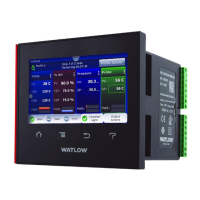Watlow F4T • 92 • Chapter 5 Function Reference
Calibration Offset
Set an offset value for a process output.
Range: -1,999.000 to 9,999.000°F
-1,110.555 to 5,555.000°C
-99,999 to 99,999 units
Cascade
Cascade control can handle a difficult process with minimal overshoot, while reaching the set
point quickly. Using cascade control minimizes the possibility of causing damage to system
components and allows for over sizing heaters for optimal heat-up rates. Heater life is also ex-
tended by reducing thermal cycling of the heater. Systems with long lag times between the
energy source (heater, steam, etc.) and the measured controlled variable are very difficult to
control accurately and or efficiently with a single control loop. This is due primarily to a lot of
energy build-up before a response is detected. When using single loop control, the likelihood
of overshooting the set point is high, this overshoot can cause damage to the heater, product
or heat transfer medium such as a heat transfer fluid.
This block is found in the Function Block Diagram editor’s Library when working with a con-
troller that offers cascade control. The number of these FBs available is shown within the pa-
renthesis and is dependent on the controller part number.
When configuring the Cascade FB the user must select either Process or Deviation for the cas-
cade Function setting.
Process
When process is selected, the outer loop will compare the outer process variable (PVO) to its
set point. Based on the result of the comparison (error) the outer loop will generate a power
level. This power level will be converted and scaled to serve as the set point for the inner
loop. The range is defined by the user (y-axis) where the scaling (x-axis) is done automatically
based on whether or not the control action is set for heat, cool or both. As an example, in
the graph below for heat only, the user setting for Control Action would be heat with Range
Low set to 190° and Range High set to 210°. In each graphic shown below, the solid line illus-
trates the proportional relationship between the scaling factors and the user defined range.
The resultant inner loop set point is displayed (dashed lines) before any filtering or offset is
applied.

